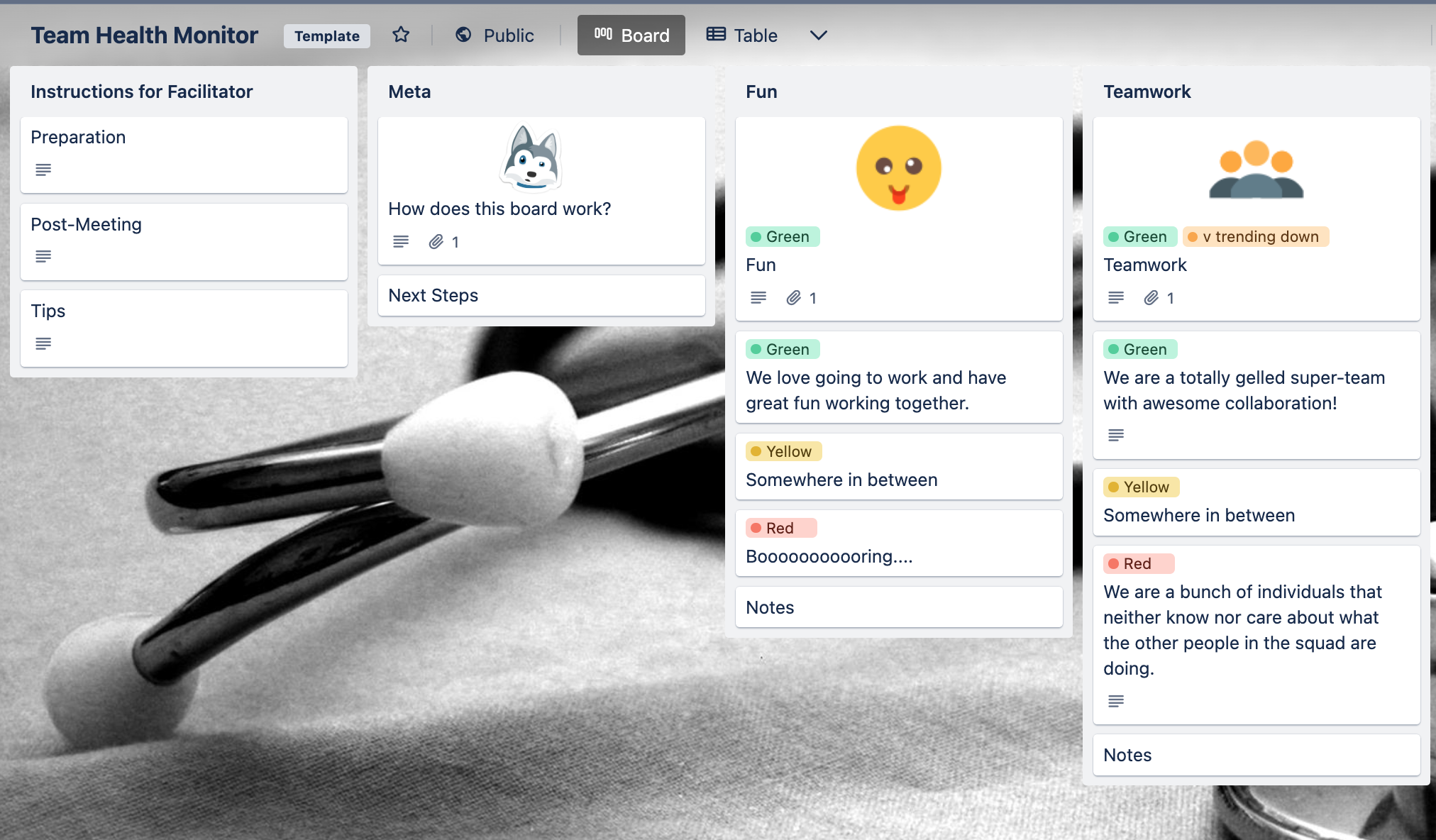There’s a reason we schedule routine dental cleanings, regularly change the oil in our cars, and call our friends to see how they’re doing: When we care about something, we check in.
The same goes for workplace priorities. From OKRs to KPIs to to performance reviews, managers have many ways to check in with their team. But if you really want to get a deep understanding of your team’s dynamics, performance, and happiness, try the team health check.
What is a team health check?
A team health check is a tool used to gauge how well coworkers are collaborating and how they, as a whole, feel about the work they’re doing together over time.
The concept of a team health check is deeply rooted in agile methodology, although it’s useful for non-technical teams, as well. One of the twelve agile principles states: “At regular intervals, the team reflects on how to become more effective, then tunes and adjusts its behavior accordingly.” And that’s exactly what a team health check facilitates.
And unlike OKRs or pulse surveys, a team health check is more collaborative and is often (though not always) done together in a real-time meeting.
What is the purpose of a team health check?
A team health check helps you gather feedback about what’s working and what’s not, straight from the people involved. While celebrating wins is crucial to boosting team morale, the main purpose of the team health check is to pinpoint weak spots and make a plan to strengthen them.
But before you begin a health check, you first need to know what to look for.
The 8 research-backed attributes of healthy teams
Atlassian identified the following eight attributes of healthy teams based on years of research across internal and external teams. Here’s what to look for in your own team:
- Team cohesion: Do team members trust, respect, and feel connected to each other?
- Balance: Does the team have the right people, skills, and clearly-defined roles to successfully deliver on their responsibilities?
- Encouragement of differences: Does your team seek out diverse points of view, and do they work through their differences with respect?
- Shared understanding: Are all team members on the same page about their mission, purpose, and key milestones?
- Value and metrics: Is your team clear on the value they provide, their definition of success, and the metrics for each? Do they use those metrics in their decision making?
- Suitable ways of working: Do the tools, decision-making processes, and meeting/collaboration policies you use empower your team members to do their jobs well?
- Engagement and support: (This attribute focuses on how your team relates to other teams and gives support.) Do other teams know how and when to engage with your team? Are cross-team dependencies clear?
- Continuous improvement: Does your team celebrate wins and fix weak spots? Do they maintain feedback loops?
Try this free team health-check template
If you want to borrow a real-life team health check process, Atlassian’s Health Monitor is free for anyone to use. It takes about 90 minutes to complete (not including prep time) and can be adapted for remote or in-person teams.
And if you want a digital supplement to the Health Monitor, we’ve got you covered with a free Team Health Monitor Trello template. This template makes it easy for people to vote and capture feedback all in one online space, whether you’re meeting in-person on remotely.
How to conduct a team health check in 5 simple steps
Typically, the team health check involves a meeting coupled with a formalized survey that solicits feedback and allows for discussion.
Word to the wise: A team health check will only be accurate if you’ve already cultivated psychological safety in your work environment. To successfully run a team health check, it’s important that each teammate feels comfortable sharing critical feedback in front of others and understands they won’t be punished for being honest.
If this is a struggle for your team, learn more about how to increase psychological safety before doing the team health check. Check out some of these meeting ideas that help promote team bonding.
Step 1: Decide on your health indicators and frequency
Our Trello template includes the eight attributes of healthy teams we discussed earlier, plus some others that you may want to incorporate. But the beauty of our templates (like everything else in Trello) is that they’re customizable.
Once you’ve created a set of health measurements that work for your team and organization, decide how frequently you’ll run a team health check. Doing one every quarter or every month is a good place to start. Checking in more frequently than that might not allow enough time to pass for significant changes to show up.
Some organizations choose to do a team health check as part of their retrospective meetings, which normally happen at the end of each sprint. Retrospectives and team health checks share a commonality: They both encourage team reflection to improve future interactions and performance. Unlike retros, however, team health checks focus more on underlying emotional dynamics happening within a team (think trust, connectedness, and empathy). Having said that, incorporating a team health check into a retrospective makes perfect sense!
Step 2: Get your tools in place
Whether your team is in-person, remote, or hybrid, you’ll need a few things before you host your team health check:
- A meeting time. While many meetings can be done asynchronously, the health check is likely to yield better results if everyone can participate at the same time.
- A way to vote. We’ll go into more detail on this in the next section.
- Video conferencing. If even one person on your team is remote and cannot easily travel to your site, consider making the health check meeting virtual (even if some of you are in the same room). That way, each person can join from their laptop, leveling the playing field for all.
- A way to take notes. Assign a notetaker to capture all that juicy feedback you’ll be getting. In the Trello template, you can store notes on the Notes card for easy reference.

Step 3: Vote on each health indicator
The voting system on a team health check is simple. Participants choose one of the following three options to show how much they agree with each statement about the team’s health:
Thumbs up: Agree
Thumbs sideways: A little shaky
Thumbs down: Disagree
For in-person meetings, you can simply have your team members use their hands to signal a thumbs up, thumbs sideways, or thumbs down.
If you use the Trello template, a voting feature is built right into each card. Just hover over the card you want to vote for and type “v.” When you do this, you’ll see a little gray thumbs up appear on the bottom of the card to indicate you’ve cast a vote for it.
Alternatively, you can get really creative like this person’s team and challenge your employees to find green, yellow, and red objects around them to use as votes. Green is thumbs-up, yellow is sideways, and red is thumbs-down.

Important note: To prevent bias, wait until everyone is ready to vote and then do a countdown so that everyone places their vote at the same time.
Step 4: Discuss the reasoning behind each vote
After everyone votes, open up the floor for discussion. Invite each team member to share their rationale for their vote. If you’re using Trello, team members can leave comments on each card.
Remember, the team health check is about celebrating what’s going well and fixing what’s not working. Take notes during this time, and be sure to include details on any areas of improvement.
Step 5: Celebrate top health indicators and make a plan to improve the lowest ones
Now that you have lots of feedback to sift through, narrow it down to the top three wins and the top three areas of improvement.
Before you end the meeting, spend some time collaborating on an action plan addressing how you and your team will improve those three health indicators by the next team health check. You can begin by looking at each one and asking your team, “What’s the smallest step we can take to get better in this area?”
Make the team health check a part of your routine
Now that you’ve successfully completed your first team health check, congratulate yourself and your team! Remember, though, the team health check isn’t something you complete and forget. Just like you wouldn’t skip those six-month dental cleanings, making the team health check a regular thing keeps your team strong.
But it’s just one part of team health. Though you’ll gather essential information and come up with action steps during a team health check, it’s on you and your people to bring those learnings to life.









































